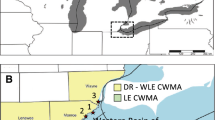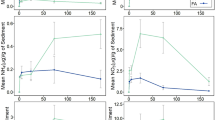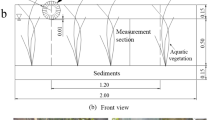Abstract
A 4.6-ha urban stormwater treatment wetland complex in southwest Florida has been investigated for several years to understand its nutrient retention dynamics. This study investigates the role of aquatic vegetation, both submerged vegetation (such as benthic macrophytic and algal communities) and emergent plant communities, on changes in nutrient fluxes through the wetlands. Gross and net primary productivity of water column communities and net primary productivity of emergent macrophytes were used to estimate nutrient fluxes through vegetation in these wetlands using biannual biomass, nutrient concentrations of plant material, and areal coverage data. Emergent macrophyte net primary productivity was estimated as the difference between the increase of productivity during the wet season and the loss during the dry season which, in turn, suggested approximately 0.11g-N m− 2 y− 1 and 0.09g-P m− 2 yr− 2 being removed, primarily from the soil, by emergent vegetation. Water column primary productivity accounted for a much larger flux of nutrients with approximately 39.6g-N m− 2 yr− 1 and 2.4g-P m− 2 yr− 1 retained in algal communities. These fluxes, combined with measurements in parallel studies, allowed us to develop preliminary nutrient budgets for these wetlands and identify gaps, or missing fluxes, in our models for these wetlands. The results further validated previous findings that suggested that there are large inputs of nitrogen (up to 62.3g-N m− 2 yr− 1) that are not accounted for by the pumped inflow. Additionally, management suggestions are provided to improve water quality by identifying vegetative species that are most effective at retaining nutrients.







Similar content being viewed by others
Data Availability
The datasets generated and analyzed during the current study are available from the corresponding author or the Everglades Wetland Research Park in Naples, Florida on reasonable request.
References
Anderson DM, Glibert PM, Burkholder JM (2002) Harmful algal blooms and eutrophication: Nutrient sources, composition, and consequences. Estuaries 25:704–726
Bishop M, Bays J, Griffin M, Gramer W (2014) More than a pretty space: Stormwater treatment wetlands with multiple benefits at Freedom Park, Naples, FL. Proc Water Environ Fed 2012:8094–8115. https://doi.org/10.2175/193864712811704620
Brand LE, Compton A (2007) Long-term increase in Karenia brevis abundance along the Southwest Florida coast. Harmful Algae 6:232–252. https://doi.org/10.1016/J.HAL.2006.08.005
Brown SL (1978) A comparison of cypress ecosystems in the landscape of Florida. University of Florida, Gainesville
Budny ML, Benscoter BW (2016) Shrub encroachment increases transpiration water loss from a subtropical wetland. Wetlands 36:631–638. https://doi.org/10.1007/s13157-016-0772-5
Candela L, Fabregat S, Josa A et al (2007) Assessment of soil and groundwater impacts by treated urban wastewater reuse. A case study: Application in a golf course (Girona, Spain). Sci Total Environ 374:26–35. https://doi.org/10.1016/j.scitotenv.2006.12.028
Castro-Morales LM, Quintana-Ascencio PF, Fauth JE et al (2014) Environmental factors affecting germination and seedling survival of carolina willow (Salix caroliniana). Wetlands 34:469–478. https://doi.org/10.1007/s13157-014-0513-6
Chen W, Lu S, Jiao W et al (2013) Reclaimed water: A safe irrigation water source? Environ Dev 8:74–83. https://doi.org/10.1016/j.envdev.2013.04.003
Cooper JR, Gilliam JW, Daniels RB, Robarge WP (1987) Riparian areas as filters for agricultural sediment. Soil Sci Soc Am J 51:416–420. https://doi.org/10.2136/sssaj1987.03615995005100020029x
Craft CB, Casey WP (2000) Sediment and nutrient accumulation in floodplain and depressional freshwater wetlands of Georgia, USA. Wetlands 20:323–332
Cronk JK, Mitsch WJ (1994) Aquatic metabolism in four newly constructed freshwater wetlands with different hydrologic inputs. Ecol Eng 3:449–468. https://doi.org/10.1016/0925-8574(94)00012-3
Fink DF, Mitsch WJ (2004) Seasonal and storm event nutrient removal by a created wetland in an agricultural watershed. Ecol Eng 23:313–325. https://doi.org/10.1016/J.ECOLENG.2004.11.004
Food and Agriculture Organization of the United Nations [FAO] (2015) World fertilizer trends and outlook to 2018. FAO, Rome
Gannon D, Berens McCabe E, Camilleri S et al (2009) Effects of Karenia brevis harmful algal blooms on nearshore fish communities in southwest Florida. Mar Ecol Prog Ser 378:171–186. https://doi.org/10.3354/meps07853
Glibert PM (2017) Eutrophication, harmful algae and biodiversity — Challenging paradigms in a world of complex nutrient changes. Mar Pollut Bull 124:591–606. https://doi.org/10.1016/j.marpolbul.2017.04.027
Glibert PM, Burford MA (2017) Globally changing nutrient loads and harmful algal blooms: Recent advances, new paradigms, and continuing challenges. Oceanography 30:58–69. https://doi.org/10.2307/24897842
Griffiths LN, Mitsch WJ (2017) Removal of nutrients from urban stormwater runoff by storm-pulsed and seasonally pulsed created wetlands in the subtropics. Ecol Eng 108:414–424. https://doi.org/10.1016/j.ecoleng.2017.06.053
Griffiths LN, Mitsch WJ (2020) Nutrient retention via sedimentation in a created urban stormwater treatment wetland. Sci Total Environ 727:138337. https://doi.org/10.1016/j.scitotenv.2020.138337
Hagerthey SE, Cole JJ, Kilbane D (2010) Aquatic metabolism in the Everglades: Dominance of water column heterotrophy. Limnol Oceanogr 55:653–666. https://doi.org/10.4319/lo.2010.55.2.0653
Heisler J, Glibert PM, Burkholder JM et al (2008) Eutrophication and harmful algal blooms: A scientific consensus. Harmful Algae 8:3–13. https://doi.org/10.1016/J.HAL.2008.08.006
Ho JC, Michalak AM (2017) Phytoplankton blooms in Lake Erie impacted by both long-term and springtime phosphorus loading. J Great Lakes Res 43:221–228. https://doi.org/10.1016/j.jglr.2017.04.001
Hoagland CR, Gentry LE, David MB, Kovacic DA (2001) Plant nutrient uptake and biomass accumulation in a constructed wetland. J Freshw Ecol 16:527–540. https://doi.org/10.1080/02705060.2001.9663844
Hobbie SE, Finlay JC, Janke BD et al (2017) Contrasting nitrogen and phosphorus budgets in urban watersheds and implications for managing urban water pollution. Proc Natl Acad Sci U S A 114:4177–4182. https://doi.org/10.1073/pnas.1618536114
Howarth RW, Sharpley A, Walker D (2002) Sources of nutrient pollution to coastal waters in the United States: Implications for achieving coastal water quality goals. Estuaries 25:656–676. https://doi.org/10.1007/BF02804898
Hu C, Muller-Karger FE, Swarzenski PW (2006) Hurricanes, submarine groundwater discharge, and Florida’s red tides. Geophys Res Lett 33:L11601. https://doi.org/10.1029/2005GL025449
Janke BD, Finlay JC, Hobbie SE (2017) Trees and streets as drivers of urban stormwater nutrient pollution. Environ Sci Technol 51:9569–9579. https://doi.org/10.1021/acs.est.7b02225
Johnston CA, Bubenzer GD, Lee GB (1984) Nutrient trapping by sediment deposition in a seasonally flooded lakeside wetland. J Environ Qual 13:283–290. https://doi.org/10.2134/jeq1984.00472425001300020022x
Katz BG, Griffin DW, Davis JH (2009) Groundwater quality impacts from the land application of treated municipal wastewater in a large karstic spring basin: Chemical and microbiological indicators. Sci Total Environ 407:2872–2886. https://doi.org/10.1016/j.scitotenv.2009.01.022
Kirkpatrick B, Fleming LE, Squicciarini D et al (2004) Literature review of Florida red tide: Implications for human health effects. Harmful Algae 3:99–115. https://doi.org/10.1016/J.HAL.2003.08.005
Koerselman W, Verhoeven JTA (1992) Nutrient dynamics in mires of various trophic status: nutrient inputs and outputs and the internal nutrient cycle. Fens bogs Netherlands 397–432. https://doi.org/10.1007/978-94-015-7997-1_9
Kovacic DA, David MB, Gentry LE et al (2000) Effectiveness of constructed wetlands in reducing nitrogen and phosphorus export from agricultural tile drainage. J Environ Qual 29:1262. https://doi.org/10.2134/jeq2000.00472425002900040033x
Land M, Granéli W, Grimvall A et al (2016) How effective are created or restored freshwater wetlands for nitrogen and phosphorus removal? A systematic review. Environ Evid 5:9. https://doi.org/10.1186/s13750-016-0060-0
Lapointe BE (2019) Chasing nutrients and algal blooms in gulf and caribbean waters: A personal story. Gulf Caribb Res 30:xvi–xxx. https://doi.org/10.18785/gcr.3001.10
Lehman JT (1980) Release and cycling of nutrients between planktonic algae and herbivores. Limnol Oceanogr 25:620–632. https://doi.org/10.4319/lo.1980.25.4.0620
Marois DE, Mitsch WJ (2015) Coastal protection from tsunamis and cyclones provided by mangrove wetlands – a review. Int J Biodivers Sci Ecosyst Serv Manag 11:71–83. https://doi.org/10.1080/21513732.2014.997292
Marois DE, Mitsch WJ, Song K et al (2015) Estimating the importance of aquatic primary productivity for phosphorus retention in Florida Everglades mesocosms. Wetlands 35:357–368. https://doi.org/10.1007/s13157-015-0625-7
Mitsch WJ, Anderson CJ, Hernandez ME et al (2005) Net primary productivity of macrophyte communities in the experimental marshes after eleven growing seasons
Mitsch WJ, Dorge CL, Wiemhoff JR (1979) Ecosystem dynamics and a phosphorus budget of an alluvial cypress swamp in southern Illinois. Ecology 60:1116–1124. https://doi.org/10.1126/science.151.3712.864-c
Mitsch WJ, Gosselink JG (2015) Wetlands, 5th edn. John Wiley & Sons, Inc., Hoboken
Mitsch WJ, Kaltenborn KS (1980) Effects of copper sulfate application on diel dissolved oxygen and metabolism in the fox chain of lakes. Trans Illinois State Acad Sci 73:55–64
Mitsch WJ, Reeder BC (1991) Modelling nutrient retention of a freshwater coastal wetland: estimating the roles of primary productivity, sedimentation, resuspension and hydrology. Ecol Modell 54:151–187. https://doi.org/10.1016/0304-3800(91)90075-C
Mitsch WJ, Day JW, Gilliam JW et al (2001) Reducing nitrogen loading to the Gulf of Mexico from the Mississippi river basin: strategies to counter a persistent ecological problem: Ecotechnology—the use of natural ecosystems to solve environmental problems—should be a part of efforts to shrink the zone of hypoxia in the Gulf of Mexico. BioScience 51(5):373–388. https://doi.org/10.1641/0006-3568(2001)051[0373:RNLTTG]2.0.CO;2
Mitsch WJ, Zhang L, Waletzko E, Bernal B (2014) Validation of the ecosystem services of created wetlands: Two decades of plant succession, nutrient retention, and carbon sequestration in experimental riverine marshes. Ecol Eng 72:11–24. https://doi.org/10.1016/J.ECOLENG.2014.09.108
Moon M, Rattray MR, Putz FE, Bowes G (1993) Acclimatization to flooding of the Hherbaceous vine, Mikania scandens. Funct Ecol 7:610. https://doi.org/10.2307/2390138
Nesbit TA, Mitsch WJ (2018) Hurricane and seasonal effects on hydrology and water quality of a subtropical urban stormwater wetland. Ecol Eng 120:134–145. https://doi.org/10.1016/j.ecoleng.2018.05.041
Nichols DS (1983) Capacity of natural wetlands to remove nutrients from wastewater. J Water Pollut Control Fed 55:495–505
Noe GB, Hupp CR (2009) Retention of riverine sediment and nutrient loads by coastal plain floodplains. Ecosystems 12:728–746. https://doi.org/10.1007/s10021-009-9253-5
Noe GB, Hupp CR, Schenk ER, Rybicki NR (2013) Science summary — Sediment and nutrient trapping in the flood plain of Difficult Run, Virginia and implications for the restoration of Chesapeake Bay
Odum EP (1969) The strategy of ecosystem development. Science 164:262–270. https://doi.org/10.1126/science.164.3877.262
Odum HT (1956) Primary production in flowing waters. Limnol Oceanogr 1:102–117. https://doi.org/10.4319/lo.1956.1.2.0102
Odum HT, Hoskin CM (1958) Comparative studies on the metabolism of marine waters. Publ Inst Mar Sci Texas 5:16–46
Paerl HW (1997) Coastal eutrophication and harmful algal blooms: Importance of atmospheric deposition and groundwater as “new” nitrogen and other nutrient sources. Limnol Oceanogr 42:1154–1165. https://doi.org/10.4319/lo.1997.42.5_part_2.1154
Pant HK, Reddy KR (2001) Hydrologic influence on stability of organic phosphorus in wetland detritus. J Environ Qual 30:668–674. https://doi.org/10.2134/jeq2001.302668x
Quintana-Ascencio PF, Fauth JE, Castro Morales LM et al (2013) Taming the beast: Managing hydrology to control carolina willow (Salix caroliniana) seedlings and cuttings. Restor Ecol 21:639–647. https://doi.org/10.1111/j.1526-100X.2012.00940.x
Richardson CJ, Marshall PE (1986) Processes controlling movement, storage, and export of phosphorus in a Fen Peatland. Ecol Monogr 56(4):279–302
Robinson GGC, Gurney SE, Goldsborough LG (1997) Response of benthic and planktonic algal biomass to experimental water-level manipulation in a prairie lakeshore wetland. Wetlands 17:167–181. https://doi.org/10.1007/BF03161407
Rockström J, Steffen W, Noone K et al (2009) A safe operating space for humanity. Nature 461:472–475
Saunders DL, Kalff J (2001) Nitrogen retention in wetlands, lakes and rivers. Hydrobiologia 443:205–212. https://doi.org/10.1023/A:1017506914063
Staehr PA, Bade D, Van de Bogert MC et al (2010) Lake metabolism and the diel oxygen technique: State of the science. Limnol Oceanogr Methods 8:628–644. https://doi.org/10.4319/lom.2010.8.0628
Tanner C, Kadlec RH (2003) Oxygen flux implications of observed nitrogen removal rates in subsurface-flow treatment wetlands. Water Sci Technol 48:191–198. https://doi.org/10.2166/wst.2003.0317
Tanner CC, Kadlec RH, Gibbs MM et al (2002) Nitrogen processing gradients in subsurface-flow treatment wetlands - Influence of wastewater characteristics. Ecol Eng 18:499–520. https://doi.org/10.1016/S0925-8574(02)00011-3
Tuttle CL, Zhang L, Mitsch WJ (2008) Aquatic metabolism as an indicator of the ecological effects of hydrologic pulsing in flow-through wetlands. Ecol Indic 8:795–806. https://doi.org/10.1016/j.ecolind.2007.09.005
Vitousek PM, Mooney HA, Lubchenco J, Melillo JM (1997) Human domination of Earth’s ecosystems. Science 277:494–499
Vymazal J (2007) Removal of nutrients in various types of constructed wetlands. Sci Total Environ 380:48–65. https://doi.org/10.1016/j.scitotenv.2006.09.014
Weisberg RH, Liu Y, Lembke C et al (2019) The coastal ocean circulation influence on the 2018 west Florida shelf K. brevis red tide bloom. J Geophys Res Ocean 124:2501–2512. https://doi.org/10.1029/2018JC014887
Wells ML, Trainer VL, Smayda TJ et al (2015) Harmful algal blooms and climate change: Learning from the past and present to forecast the future. Harmful Algae 49:68–93. https://doi.org/10.1016/j.hal.2015.07.009
White J (2006) Reduction of phamaceutical compounds from municipal wastewater in a constructed wetland, Orlando, FL. In: American Society of Agronomy-Crop Science Society of America-Soil Science Society of America, 2006 Interational Meetings
White JR, Wang H, Jawitz JW, Sees MD (2004) Rejuvenating the largest treatment wetland in Florida: Tracer moment and model analysis of wetland hydraulic performance. In: American Geophysical Union, Fall Meeting 2004
Wu AM, Franz EH, Chen S, Wu M (2001) Oxygen fluxes and ammonia removal efficiencies in constructed treatment wetlands. Water Environ Fed 73:661–666. https://doi.org/10.2175/106143001X143394
Yi Q, Lu W, Yu J, Kim Y (2010) Characteristics of nutrient retention in a stormwater wetland during dry and wet days. Water Sci Technol 61:1535–1545. https://doi.org/10.2166/wst.2010.108
Acknowledgements
This work was partially supported by Collier County, FL, contract 814646852. We also appreciate Collier County for permitting us to conduct this research at Freedom Park. Salary of the first author was paid in part by a generous donation to the FGCU Foundation by Dennis and Janet Vasey, Naples, Florida. Field sampling was assisted by Andrew Wilson, Bing Bing Jiang, Feng Li, Linfeng Li, and other graduate and undergraduate students and visiting scientists to FGCU’s Everglades Wetlands Research Park. Editorial and content contributions were provided by Drs. Mark C. Rains, Kai C. Rains, and Ariel E. Lugo.
Funding
Partial financial support was received from Collier County, FL, contract 814646852. Salary for the first author was partially paid for by a generous donation to the FGCU Foundation by Dennis and Janet Vasey, Naples, Florida.
Author information
Authors and Affiliations
Contributions
All authors contributed to the study conception, design and data collection. Material preparation was performed by Lauren N. Griffiths and Taylor Nesbit Haupt. Data analysis was performed by Lauren N. Griffiths and Li Zhang. The first draft of the manuscript was written by Lauren N. Griffiths. William J. Mitsch secured funding for much of the project and wrote an initial final report to Collier County and provided editorial comments. All authors read and approved the final manuscript.
Corresponding author
Ethics declarations
Conflict of interest
The authors certify that there are no conflicts of interest to disclose.
Additional information
Publisher’s note
Springer Nature remains neutral with regard to jurisdictional claims in published maps and institutional affiliations.
Rights and permissions
About this article
Cite this article
Griffiths, L.N., Haupt, T.N., Zhang, L. et al. Role of emergent and submerged vegetation and algal communities on nutrient retention and management in a subtropical urban stormwater treatment wetland. Wetlands Ecol Manage 29, 245–264 (2021). https://doi.org/10.1007/s11273-020-09781-6
Received:
Revised:
Accepted:
Published:
Issue Date:
DOI: https://doi.org/10.1007/s11273-020-09781-6




